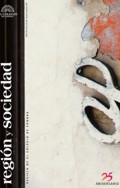Abstract
We propose a new interpretation of the colonial regime in the province of Sonora and in the northern part of the province of Sinaloa -between the Gila and Fuerte rivers-, based on the breakdown the missions registered beginning in 1681, evidenced by a succession of interethnic rebellions and an increase in the population's spatial mobility. All these facts lead us to consider that the emphasis given to the missionaries' expulsion in 1767 is rather a victimization strategy; it is also argued that the missionaries' use of physical and symbolic coercion is inherent to the nature of the regime they established in the region. Furthermore, the indigenous societies' capacity for political response, which recovered after the demographic decline and strengthened throughout the 18th century, is more complex than what is evidenced by the missionaries' texts. In addition, the civil and presidial population living in this region had economic and social dynamics of their own which were not subordinate to the missionaries.

This work is licensed under a Creative Commons Attribution-NonCommercial 4.0 International License.
Copyright (c) 2017 Ignacio Almada Bay, José Marcos Medina Bustos, María del Valle Borrero Silva




















